
North Adams is a city in Berkshire County, Massachusetts, United States. It is part of the Pittsfield, Massachusetts Metropolitan Statistical Area. Its population was 13,708 as of the 2010 census. Best known as the home of the largest contemporary art museum in the United States, the Massachusetts Museum of Contemporary Art, North Adams has in recent years become a center for tourism, culture and recreation.

Daniel Day was an American pioneer in woolen manufacturing.
Luke Taft was an industrial pioneer in the manufacture of woolens in 19th century New England.

The Waucantuck Mill Complex was a mill complex in Uxbridge, Massachusetts. Despite its 2010 demolition, it is still listed on the National Register of Historic Places. The original Luke Taft Mill, built in 1824, on the West River was very close to the present site of the Waucatuck Mill complex. The Waucantuck complex was planned for a condominium and retail complex, underway in 2009. Both are very close to and virtually part of the Wheelockville District, where the Stanley Woolen Mill was built in 1852. Wash and wear fabrics were first developed at this mill in the 20th century. Products were produced under the name of "Indian Head". In the 1960s the former holdings of American Woolen Company were eventually acquired by a company by that name in Uxbridge, MA. Originally the Uxbridge Worsted Company had proposed a buyout of American Woolen to become America's largest woolen conglomerate. The Town of Uxbridge was synonymous with the textile industry and its earliest and later developments.

The Crane and Company Old Stone Mill Rag Room is one of the oldest surviving buildings of Crane & Co., one of the oldest papermaking businesses in Berkshire County, Massachusetts. It is located in southwestern Dalton, on a site where paper has been manufactured since the early 19th century. The building, originally used for processing rags, has housed the Crane Museum of Papermaking since 1930, and was designated a National Historic Landmark in 1983.

The Bigelow Carpet Company Woolen Mills are a historic mill complex on Main Street in Clinton, Massachusetts. The sprawling mill complex was built or expanded by the Bigelow Carpet Company, one of Clinton's leading business for much of the 19th and early 20th centuries. The complex was listed on the National Register of Historic Places in 1983. It continues to be adaptivelry reused by smaller businesses.

The Hayward Mill is a historic mill complex at the junction of North and Cook Streets, on the Mumford River in Douglas, Massachusetts. The site, with an industrial history dating to the 18th century, is populated by a series of connected buildings dating to 1880 or later. The mill was the first financial successful textile operation in Douglas, and was operated until the 1960s. The mill complex was listed on the National Register of Historic Places in 1991. It has been converted to residential use.

The Whittenton Mills Complex is a historic textile mill site located on Whittenton Street in Taunton, Massachusetts, on the banks of the Mill River. The site has been used for industrial purposes since 1670, when James Leonard built an iron forge on the west bank of the river. The first textile mill was built in 1805 and expanded throughout the 19th century. The complex was added to the National Register of Historic Places in 1984, and now contains various small businesses.
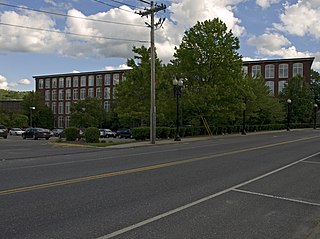
The Berkshire Mill No. 1 is a historic mill complex on Hoosac Street in the center of Adams, Massachusetts. Built in 1895 by the locally prominent Plunkett family, it is an important surviving reminder of the town's industrial textile past. Now converted into mixed residential and commercial use, it was listed on the National Register of Historic Places in 1982.
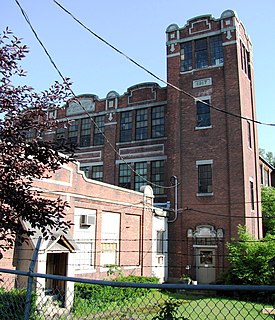
The Blackinton Historic District is a historic district in the western part of North Adams, Massachusetts, roughly along Massachusetts Avenue between Ashton and Doanes Avenues and Church Hill and the Boston & Maine Railroad. The district, which encompasses North Adams' best preserved mill village, was added to the National Register of Historic Places in 1985.

The Johnson Manufacturing Company was a historic mill complex at 65 Brown Street in North Adams, Massachusetts. Developed beginning in 1872 and enlarged through the early 20th century, it was at the time of its 1985 listing on the National Register of Historic Places a well-preserved example of late 19th century industrial architecture, used for the production of textiles for many years. The complex was demolished in 2007.

Phillips Woolen Mill is a historic mill at 71 Grove Street in Adams, Massachusetts. With a construction history dating to the mid-19th century, it is a good example of small textile mill complex of that period, containing elements that date from the 1920s potentially back as far as the 1830s. The mill complex was added to the National Historic Register in 1982.
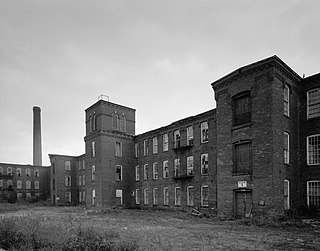
The Renfrew Mill No. 2 was a historic mill complex at 217 Columbia Street in Adams, Massachusetts. Most of its buildings were built between 1867 and 1878, and were brick buildings with Italianate styling. They were built by the Renfrew Manufacturing Company, a textile manufacturer, to replace an earlier complex further down Columbia Street that had been demolished. The property was acquired by the Arnold Print Works in 1928. The mill was the town's largest employer for much of the second half of the 19th century.

Windsor Print Works is a historic textile mill at 121 Union Street in North Adams, Massachusetts. Founded in 1829, with buildings dating to 1872, it was one of the first textile mills in western Massachusetts, and the first place in the United States to create printed cotton fabric. It was listed on the National Register of Historic Places in 1973. The property now houses a variety of arts-related and light manufacturing businesses.

The North Canal Historic District of Lawrence, Massachusetts, encompasses the historic industrial heart of the city. It is centered on the North Canal and the Great Stone Dam, which provided the waterpower for its many mill complexes. The canal was listed on the National Register of Historic Places in 1975, while the district was first listed in 1984, and then expanded slightly in 2009.
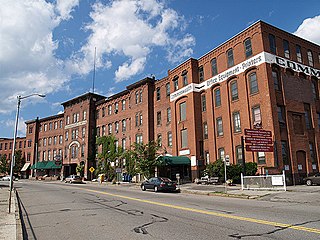
The Washburn and Moen North Works District encompass an industrial complex that housed the largest business in Worcester, Massachusetts in the second half of the 19th century. Founded in 1831, Washburn and Moen was an innovating manufacturer of wire and related products, including telegraph wire, barbed wire, which were used in large quantities during America's westward expansion. The company's Grove Street complex was developed in the 1860s and 1870s and was used all or in part by the company and it successors until 1943. It continues to be used for light industrial manufacturing, and was listed on the National Register of Historic Places in 1980.

Stanley Woolen Mill is the common historic name applied to a defunct company based in southeastern Massachusetts and to the company's buildings which stand at the southern entrance to the Blackstone River and Canal Heritage State Park. The mill is an important footnote in the history of the textile industry in America. Stanley Woolen Mill is the centerpiece of the Central Woolen Mills District which is part of the National Historic Register.
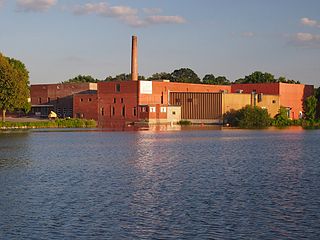
The Faribault Woolen Mill Company is a textile manufacturing company in Faribault, Minnesota, United States, that produces and sells wool blankets and other woolen products. Its products included ingeo, cotton, acrylic and wool bed blankets, pillows, mattresses, pads, and baby blankets, and wool, ingeo and blend throws. The company primarily serves various enterprise sectors. It offers its products through its store in Faribault and nationwide through retailers.

The Winthrop Mills Company is a historic textile mill complex at 149-151 Main Street in Winthrop, Maine. Developed mainly between the late 19th and mid-20th centuries, it was the nation's largest manufacturer of woolen blankets for many years, and a major local employer for about 150 years. It was listed on the National Register of Historic Places in 2014.
Braytonville is a former factory village, one mile west of downtown North Adams that grew around a stone mill, constructed in 1832. The area is now part of the West End of North Adams and includes Brayton Elementary, Brayton Park and houses to the south along West Main Street.





















